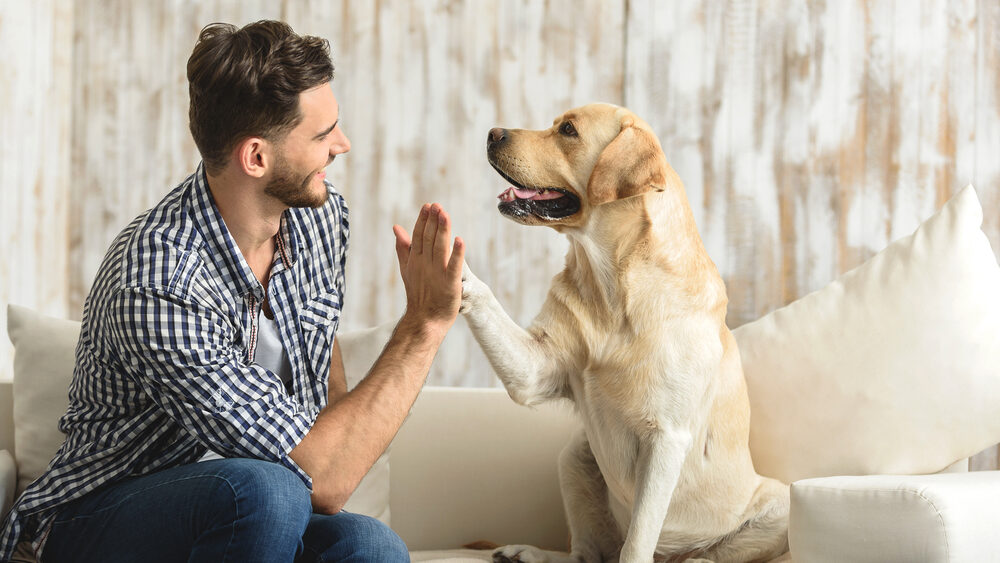Table of Contents
We can communicate with our dogs in various ways. The clearest way is through the use of markers, which allow us to give the dog feedback that its behavior is either desired or undesired.
There are basic commands with wanted and unwanted consequences, while requests are used to check in with your dog’s state of mind- there is no negative consequence associated with requests. All this must make sense to the owner before it’s applied to the dog.
In this blog post, we will discuss different methods of communication and explain how they work.
Requests-

Requests are used to check in on your dog’s state of mind. For example, if you’re unsure if your dog wants to play fetch, you can request by giving a cue/word “Play.” You can ask, “Do you want to play fetch?”
The request has no negative consequence if the dog does not want to play fetch. If the dog does, you can gauge their mental and physical by their response.
A great way to connect with your dog and get them ready for training is through “Touch” (nose touches hand) or “Focus” (eye contact). Using these request cues is a compassionate way of checking in on your dog without having them spend too much energy or feel pressure to obey.
A request cue before walking, training, or playing will help build your dog’s focus, hope, and desire to learn more, as it is a promise that usually leads to their wants.
Commands-

Commands, as opposed to requests, are like rules of the road. Let’s compare walking your dog to driving. When you get in your car, you must use a key; follow the speed limit, stop at stop signs, etc. Similarly, when we take our dog on a walk, we might ask it to lay down so that we can put on its leash; sit or stand next to us when we stop moving; keep pace with us, and walk without tugging on the leash so that we can move forward together towards our destination.
When you obey the law (agreements), you are granted certain liberties and benefits (ideally to a location you enjoy). We might be condemned by our peers, receive a caution from law enforcement, and even get just punishment if we don’t follow the laws.
If we want our dog to follow a command, we first must tell the dog what we want him to do (‘sit’, ‘stay’, etc.). Once he does as asked, then rewarded with a treat or access to an activity. If the dog does not complete the behavior satisfactorily, then appropriate correction/punishment should be given- this doesn’t necessarily have to be harsh. The removal of a treat or inability to move forward may suffice for some dogs.
Markers- the fast lane to learning.

Markers are words or signals that we use to communicate with dogs. The most common sound markers are the words “Good,” “Yes” and clickers (which produce a distinctive noise to notify the dog that it has performed correctly).
Markers are an excellent technique for teaching your dog since they allow for immediate feedback on how he’s performing or when learning commands and behaviors. Grouping markers into 3 sections will make them easier to understand.
It’s amazing to see your dog learn from you, for training to be most effective, use a neutral voice when using markers, or at least keep volume and tone consistent.
Engagement Markers-
- Ready – announces fun/training/play starts (eye contact, excitement)
- Break– do what you want (release from all commands)
- All Done– fun/training ends (not used as a correction)
Reinforcement Markers-
- Good– keep doing what you are doing (implied “Stay”. Leads to something with rewards doesn’t always get a reward (duration marker)
- Yes– on the right track, always gets a reward, come to me to get a reward (release from the present command)
- Catch/Get it– find your reward, always gets a reward (tossed away from position, the dog comes back for more)
- Uh-Uh– not what we want, try something different (no reward marker)
Punishment Marker-
- No– stopping unwanted behaviors (correction marker)
Reinforcement Markers-
By using markers such as “Yes” or “Good”, you are informing your dog that it is making the correct choice. I prefer these two options to others because they let the dog know that we approve of its actions and believe it made a great decision. Even though they serve a similar purpose, each word has a distinct meaning.
Positive Reinforcement Markers-
We first teach the dog that after a “Yes,” it will receive a reward every time the word is said. We only say it once; this informs the dog when they’ve done what we wanted and that they can come to us for a reward (food/toy/praise.)
“Good” is a way of saying that the dog is doing what we want, and it will be rewarded shortly if it continues this behavior. Good can be used frequently to motivate the dog and keep it engaged in the task at hand. Additionally, “good” adds duration to commands and is proofing a command.
Do not mistake the marker “Good” for praise phrases that include “Good” (example: a good job, good dog, dog boy.) They are used for different purposes. Properly used would look like this, when asking the dog for a simple command like “down”, as the dog does it you say the marker “Good”, which lets the dog a reward is coming. The reward can be a treat, toy, or in this case verbal praise, “Good Job”. Markers (“Good”, “Yes”) are spoken neutrally, however, the praise can be said with as much expression as you fit.
Non- Reinforcement Markers-
“Uh-uh,” tells your dog to try something different. These words inform the dog that the activity or behavior is not quite what we are seeking for, but to continue attempting. These words are spoken in a calm, pleasant tone. This is used to keep the dog interested; don’t use it as a punishment.
Correction/Punishment Markers-

Corrections and punishment markers are used to prevent undesirable behaviors. This marker informs a dog that it should stop what it’s doing (at the moment) and avoid repeating it in the future. If it continues to perform certain behaviors, it will be punished or given a negative consequence.
- Aim to avoid using corrections when teaching new behaviors or playing games (obedience or tricks). We want to keep our dog hopeful and excited about learning or playing with us during those times.
- Every dog is different in responding to feedback for unwanted behaviors; they take a lot of time to learn what is desired, especially if you are teaching them to stop something that they have already enjoyed doing.
- Suppose you find yourself applying a punishment over and over again. In that case, you need to step back and consider that there hasn’t been enough training (teaching) on what behaviors are acceptable under the circumstance it is in or the dog needs to be managed on a deeper level.
- When first teaching or reconditioning the correction marker “No” you must be timely with your punishment; keep in mind that It must be combined with an unwanted consequence.
- When first teaching a marker or punishing a behavior, You must NOT give praise, comfort, or a reward after giving a correction marker, until a significant amount of time has passed. We will spend the other 99% of our time guiding our dogs with positive reinforcement, love and compassion.
- Like all other markers and commands, you must practice correcting behaviors before you go out into the world and expect your dog to understand it.
The word “no” is my correct word of choice because it’s a common phrase people use to stop a dog. It is important to remember that corrections should never be made when we are feeling angry. Instead, the goal is to stop your dog from doing what it is doing while remaining calm and neutral.
Once a dog has been taught the desired commands or behaviors for each situation using the 3 Phases of learning, you can apply corrections to stop unwanted behaviors relating to that. When a dog has been adequately trained with many repetitions, it will do a previously “rewarded” behavior after hearing “No.”
The best way to teach this is in a location where the dog is very comfortable and has very few distractions; when the dog does something you never want again (jumping on a guest, excessive barking, humping, taking food from a table, etc.) use the word “No” (non-emotionally, it should not need to be loud). Wait one second after saying “No,” and apply something that the dog does not like. It should, at the least, interrupt the unwanted behavior and be uncomfortable enough to stop the dog.
Keep in mind– a correction marker doesn’t necessarily have to be something you add to make your dog uncomfortable (example: stomping your feet, clapping loudly, or popping the leash), sometimes you can just remove something it wants as a way of teaching it that the behavior is unwanted and won’t be rewarded.
Conclusion:
Dogs are very capable of understanding a wide range of communication signals from their human companions. With proper use of markers, commands, and requests, you can establish a clear line of communication with your dog and build a strong relationship based on mutual trust and respect.
Remember to be consistent in your training, remain patient, and have fun with your furry friend! What has been your experience trying to communicate with your dog?



